Comparative analyses of pandemic H1N1 and seasonal H1N1, H3N2, and influenza B infections depict distinct clinical pictures in ferrets
- PMID: 22110664
- PMCID: PMC3217968
- DOI: 10.1371/journal.pone.0027512
Comparative analyses of pandemic H1N1 and seasonal H1N1, H3N2, and influenza B infections depict distinct clinical pictures in ferrets
Abstract
Influenza A and B infections are a worldwide health concern to both humans and animals. High genetic evolution rates of the influenza virus allow the constant emergence of new strains and cause illness variation. Since human influenza infections are often complicated by secondary factors such as age and underlying medical conditions, strain or subtype specific clinical features are difficult to assess. Here we infected ferrets with 13 currently circulating influenza strains (including strains of pandemic 2009 H1N1 [H1N1pdm] and seasonal A/H1N1, A/H3N2, and B viruses). The clinical parameters were measured daily for 14 days in stable environmental conditions to compare clinical characteristics. We found that H1N1pdm strains had a more severe physiological impact than all season strains where pandemic A/California/07/2009 was the most clinically pathogenic pandemic strain. The most serious illness among seasonal A/H1N1 and A/H3N2 groups was caused by A/Solomon Islands/03/2006 and A/Perth/16/2009, respectively. Among the 13 studied strains, B/Hubei-Wujiagang/158/2009 presented the mildest clinical symptoms. We have also discovered that disease severity (by clinical illness and histopathology) correlated with influenza specific antibody response but not viral replication in the upper respiratory tract. H1N1pdm induced the highest and most rapid antibody response followed by seasonal A/H3N2, seasonal A/H1N1 and seasonal influenza B (with B/Hubei-Wujiagang/158/2009 inducing the weakest response). Our study is the first to compare the clinical features of multiple circulating influenza strains in ferrets. These findings will help to characterize the clinical pictures of specific influenza strains as well as give insights into the development and administration of appropriate influenza therapeutics.
Conflict of interest statement
Figures
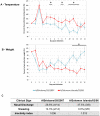

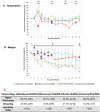
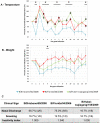
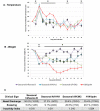

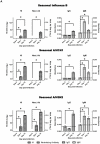
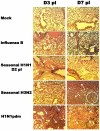
Similar articles
-
H1N1, but not H3N2, influenza A virus infection protects ferrets from H5N1 encephalitis.J Virol. 2014 Mar;88(6):3077-91. doi: 10.1128/JVI.01840-13. Epub 2013 Dec 26. J Virol. 2014. PMID: 24371072 Free PMC article.
-
Characterization of the Localized Immune Response in the Respiratory Tract of Ferrets following Infection with Influenza A and B Viruses.J Virol. 2015 Dec 30;90(6):2838-48. doi: 10.1128/JVI.02797-15. J Virol. 2015. PMID: 26719259 Free PMC article.
-
Possible increased pathogenicity of pandemic (H1N1) 2009 influenza virus upon reassortment.Emerg Infect Dis. 2011 Feb;17(2):200-8. doi: 10.3201/eid1702.101268. Emerg Infect Dis. 2011. PMID: 21291589 Free PMC article.
-
The 2009 pandemic influenza virus: where did it come from, where is it now, and where is it going?Curr Top Microbiol Immunol. 2013;370:241-57. doi: 10.1007/82_2012_221. Curr Top Microbiol Immunol. 2013. PMID: 22638836 Review.
-
[Swine influenza virus: evolution mechanism and epidemic characterization--a review].Wei Sheng Wu Xue Bao. 2009 Sep;49(9):1138-45. Wei Sheng Wu Xue Bao. 2009. PMID: 20030049 Review. Chinese.
Cited by
-
The Power of First Impressions: Can Influenza Imprinting during Infancy Inform Vaccine Design?Vaccines (Basel). 2020 Sep 19;8(3):546. doi: 10.3390/vaccines8030546. Vaccines (Basel). 2020. PMID: 32961707 Free PMC article. Review.
-
Severity and outcomes of influenza-related pneumonia in type A and B strains in China, 2013-2019.Infect Dis Poverty. 2020 Apr 22;9(1):42. doi: 10.1186/s40249-020-00655-w. Infect Dis Poverty. 2020. PMID: 32321576 Free PMC article.
-
Impaired heterologous immunity in aged ferrets during sequential influenza A H1N1 infection.Virology. 2014 Sep;464-465:177-183. doi: 10.1016/j.virol.2014.07.013. Epub 2014 Aug 1. Virology. 2014. PMID: 25086242 Free PMC article.
-
Environmental Conditions Affect Exhalation of H3N2 Seasonal and Variant Influenza Viruses and Respiratory Droplet Transmission in Ferrets.PLoS One. 2015 May 13;10(5):e0125874. doi: 10.1371/journal.pone.0125874. eCollection 2015. PLoS One. 2015. PMID: 25969995 Free PMC article.
-
Lack of group X secreted phospholipase A₂ increases survival following pandemic H1N1 influenza infection.Virology. 2014 Apr;454-455:78-92. doi: 10.1016/j.virol.2014.01.030. Epub 2014 Feb 25. Virology. 2014. PMID: 24725934 Free PMC article.
References
-
- Munster VJ, Fouchier RA. Avian influenza virus: of virus and bird ecology. Vaccine. 2009;27:6340–6344. - PubMed
-
- Sym D, Patel PN, El Chaar GM. Seasonal, avian, and novel H1N1 influenza: prevention and treatment modalities. Ann Pharmacother. 2009;43:2001–2011. - PubMed
-
- Girard MP, Tam JS, Assossou OM, Kieny MP. The 2009 A (H1N1) influenza virus pandemic: A review. Vaccine. 2010;28:4895–4902. - PubMed
-
- Rajagopal S, Treanor J. Pandemic (avian) influenza. Semin Respir Crit Care Med. 2007;28:159–170. - PubMed
Publication types
MeSH terms
Substances
Grants and funding
LinkOut - more resources
Full Text Sources

